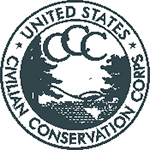History of Black Moshannon State Park
Early Settlement
Human use of this area has always been reflected in the use of Black Moshannon’s water. The Seneca Indians hunted, traded, and fished here when the present lake was a string of beaver ponds.
By 1821, the Philadelphia-Erie Pike (now PA 504) opened and settlement began with the establishment of the Antes House, a tavern, near the present bridge. This substantial hotel hosted weary travelers, pioneers, and sheep and cattle drovers making their way across the steep Allegheny Front.
Timber!
Towering white pines and hemlocks once covered the surrounding slopes and the dense foliage blocked out the sun, making it dark even on sunny days.
Weathered stumps now mark where the Beaver Mill Lumber Company cut these trees about a century ago. Some beaver ponds disappeared when loggers constructed a splash dam near the site of the present dam. The water from the splash dam was used to flush logs downstream.
Eventually the logs floated down the Susquehanna River to mills in Williamsport. In one year, the Beaver Mill Lumber Company floated over 11 million feet of logs, the largest amount put in by any single logger in Pennsylvania.
Some wood was processed at a shingle mill, located below the present beach.
By 1879, timber was cut at the steam powered Star Mill, once located at the north end of Star Mill Trail. The mill boasted 20 saws, a planer, and a shingle mill. It was supported by 150 teams of horses and mules and a second village called Beaver Mills located near Shirk’s Run at the south end of the park. When Star Mill operated, the dam was changed again to a mill pond to store logs.
Before the turn of the 20th century, Beaver Mills and Antes featured a large general store, a wagon shop, a blacksmith shop, mills, stables, a hotel-tavern, a schoolhouse, and a 10-pin alley! The schoolhouse still stands near the food concession.
The rugged people of the area helped meet the nation’s growing need for timber for mining, railroads, and construction. Some thought the timber supply would never end.
It did end, for a while. As the supply of timber decreased, lumber companies moved. The denuded landscape fell prey to fires and erosion. The job market collapsed.
In an effort to restore the land, the Commonwealth of Pennsylvania bought thousands of acres of burnt and desolate land. Pennsylvania set a path to reforestation through the establishment of the state forest system, one that now includes Moshannon State Forest.
Civilian Conservation Corps

To relieve unemployment during the Great Depression, President Franklin Roosevelt created the Civilian Conservation Corps (CCC) in 1933.
By May of that year, the Beaver Meadow CCC Camp (S-71-PA), located near the abandoned town of Beaver Mills, became one of the first to open.
It put over 200 young men to work conserving timber, water, and soil. They built roads to aid forest fire fighting and planted trees to help reforest the land.
Visitors today can travel CCC roads or hike among the rows of red pines the CCC boys planted.
The CCC boys built park facilities that visitors still enjoy, including:
Log cabins
The food concession
Picnic pavilions
Some trails
The use of Black Moshannon’s water changed again. The CCC constructed a new dam to provide swimming, boating, and fishing.